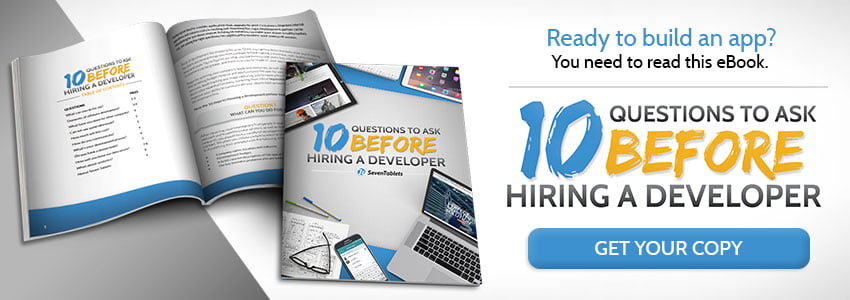The best mobile apps are built with a very specific target audience in mind. There’s really no such thing as a great “one size fits all” app because there are very, very few apps with a truly “general audience.” In fact, it’s probably fair to say that the only apps with a general audience are app store applications.
So before you begin the development process, it’s important that you — and your development team — take time to identify your target audience and get to know your mobile app users. What are their expectations? What are their needs and pain points? What are their motivations for using your app? What features and functionalities will they enjoy most? These are all critical questions that must be addressed before you write a single line of code.
Your mobile users, and their needs, should play a major role in the development process. It’s critical that you craft your user interface (UI) so it delivers an engaging user experience (UX). Let’s look at a few tips for getting to know your mobile app audience in a way that allows for a streamlined development process.
Getting to Know Your Mobile App Audience Demographics
Each mobile app audience is a bit different. It’s not uncommon for a single app to have several types of users. So, the first step is to identify your user demographics, such as characteristics of all users and traits for smaller user groups.
For instance, you might have an exclusively female audience in the United States, with all users on an Apple iPhone or iPad device. Those would be your more general demographics. It may also be possible to identify different user segments, such as female college students in their 20s, living in an urban area, or young mothers in their 30s, living in a suburban region.
The most relevant demographic traits will vary depending upon your app type, so you’ll need to take some time to identify the traits that are most relevant. Once you’ve identified the different demographic segments, you’ll be in a good position to articulate each group’s motivations for using the app, their expectations and their needs.
Know Your Mobile App User Habits and Trends
Now that you have identified your user demographics and the typical motivations for each user segment, it’s time to consider each group’s user habits and tendencies. As you do this, you may want to focus on the following points:
- How and why is this particular user type interacting with the app UI?
- What features or functionalities are most important for a good UX?
- What aesthetic elements are most likely to be appealing to the app’s users?
- Is there anything that your users would find undesirable or even offensive in the app’s UI?
- Are there any unique location-based considerations for the app’s user base?
- What’s the average user’s education level? How can you ensure that your app UI resonates with individuals who have this level of education and intelligence?
- How tech-friendly are your users? Is your app UI designed to be user-friendly for its intended audience?
- Are there any special app accessibility considerations that would improve the UX?
On the latter point concerning mobile app accessibility, developers must be careful to ensure their app can easily be utilized by the intended audience. For example, if you’re targeting the 65+ demographic where vision problems are commonplace, it would be wise to use larger, bold fonts, with lots of contrast between the font color and background. Simple design considerations such as these can mean the difference between a mobile app UI that’s engaging and user-friendly and an app that’s just impractical for users with impaired vision. This is just one example of mobile accessibility that should be taken into consideration as part of the mobile app UI design process.
Lots of these questions can be difficult to answer without input from actual users. Many mobile app developers will integrate a few key questions into the app’s registration form which allows them to gather vital information on actual user demographics. This data can be automatically imported into a predictive analytics engine and data management system that’s designed to collect data on each user’s behavior while using the app. The data can then be analyzed to arrive at some very useful insights.
Beta Releases and Beta Testing to Get to Know Your Mobile App Users
Once your development team has built the first version of your mobile app, it’s time to perform some beta testing. This is the perfect opportunity to refine and improve your platform with help from your mobile app users.
It’s vital that your beta testing group is representative of actual users. Preliminary rounds of QA testing can be performed by virtually anyone, as the focus is on identifying issues with basic functionality. But subsequent rounds of user testing should focus on the user’s travels through the app. Is the app user-friendly? Is the user interface appealing and engaging? Can users easily find and use the various features and functionalities of your app? Actual users are in the best position to offer insights into these issues.
For mobile apps that are built for the general public, you might consider a beta release. A beta release will include panels that solicit feedback from users (who will be far more forgiving of any issues if you clearly market the app as a “beta version.”)
Getting to know your mobile app users is essential for the development of a mobile app that brings exceptional results. Remember, you cannot be all things to all people, so build your app UI in a way that targets the intended user. For app development teams dealing with vastly different user profiles, it’s even possible to build a few different mobile apps using the same core features; meanwhile the styling, presentation and marketing for each app version can be tailored to suit a unique segment of users.
At 7T, we maintain a team of talented custom software and mobile app developers who are ready to help with your new mobile app or software development project. Additionally, we assist businesses with tech projects related to data governance, CRM development and system integration, among other areas of specialty. If you’re ready to collaborate with an innovative mobile app development company, contact the team at 7T today.









